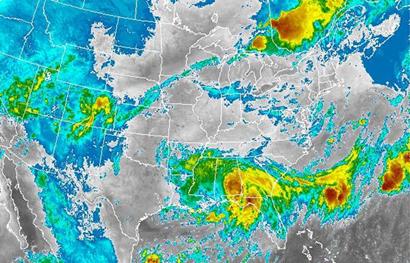A computer model that combines conventional weather-forecasting technology with machine learning has outperformed other artificial intelligence (AI)-based tools at predicting weather scenarios and long-term climate trends. The tool, described in Nature, is the first machine-learning model to generate accurate ensemble weather forecasts — ones which present a range of scenarios. Models that are more reliable and less energy-intensive could help us to better prepare for extreme weather. The team wants to incorporate more aspects of Earth science into future versions, to further improve the model’s accuracy.

A computer model that combines conventional weather-forecasting technology with machine learning has outperformed other artificial intelligence (AI)-based tools at predicting weather scenarios and long-term climate trends.
The tool, described in Nature on 22 July1, is the first machine-learning model to generate accurate ensemble weather forecasts — ones which present a range of scenarios. Its development opens the door for forecasting that is faster and less energy-intensive than existing tools, and more detailed than approaches based solely on AI.
“Traditional climate models need to be run on supercomputers. This is a model you can run in minutes,” says study co-author Stephan Hoyer, who studies deep learning at Google Research in Mountain View, California.
Current forecasting systems typically rely on general circulation models (GCMs), programmes that draw on the laws of physics to simulate processes in Earth’s oceans and atmosphere and predict how they might affect the weather and climate. But GCMs require a lot of computing power, and advances in machine learning are starting to provide a more efficient alternative. “We have terabytes or petabytes (one million times larger than a gigabyte) of historical weather data” says Hoyer. “By learning from those patterns, we can build better models.”
There are already some machine-learning forecasting models available, such as Pangu-Weather, built by the technology conglomerate Huawei, based in Shenzhen, China, and GraphCast by DeepMind, headquartered in London. These models have similar accuracy levels to typical GCMs for deterministic forecasting — an approach that generates a single weather forecast. But GCMs aren’t as reliable for ensemble forecasting, or for long-term climate predictions.
“The issue with pure machine-learning approaches is that you’re only ever training it on data it’s already seen” says Scott Hosking, who researches AI and environmental data at the Alan Turing Institute in London. “The climate is continuously changing, we’re going into the unknown, so our machine-learning models have to extrapolate into that unknown future. By bringing physics into the model, we can ensure that our models are physically constrained and cannot do anything unrealistic.”
Hoyer and his team developed and trained NeuralGCM, a model that combines “aspects from a traditional physics-based atmospheric solver with some AI components”, says Hoyer. They used the model to produce short- and long-term weather forecasts, as well as climate projections. To assess NeuralGCM’s accuracy, the researchers compared its predictions with real-world data, as well as outputs from other models, including GCMs and those based purely on machine learning.
Like current machine-learning models, NeuralGCM could produce accurate short-term, deterministic weather forecasts — between one and three days in advance — while consuming a fraction of the power required by GCMs. But it made much fewer errors than other machine-learning models when producing long-term forecasts beyond seven days. In fact, NeuralGCM’s long-term forecasts were similar to predictions made by the European Centre for Medium-Range Weather Forecast’s ensemble model (ECMWF-ENS), a GCM that is widely regarded as the gold standard for weather forecasting.
The team also tested how well the model could forecast different weather phenomena, such as tropical cyclones. They found that many of the pure machine-learning models produced inconsistent and inaccurate forecasts compared with both NeuralGCM and ECMWF-ENS. The researchers even compared NeuralGCM with ultra-high-resolution climate models known as global storm-resolving models. NeuralGCM could produce more-realistic tropical-cyclone counts and trajectories in a shorter time.
Being able to predict such events is “so important for improving decision-making abilities and preparedness strategies”, says Hosking. Hoyer and his colleagues are keen to further refine and adapt NeuralGCM. “We’ve been working on the atmospheric component of modelling the Earth’s system … It’s perhaps the part that most directly affects day-to-day weather,” Hoyer says. He adds that the team wants to incorporate more aspects of Earth science into future versions, to further improve the model’s accuracy.
Sources:
NATURE
https://www.nature.com/articles/d41586-024-02391-9 .
Provided by the IKCEST Disaster Risk Reduction Knowledge Service System
Comment list ( 0 )
